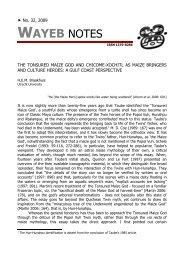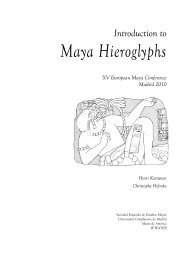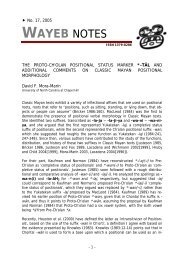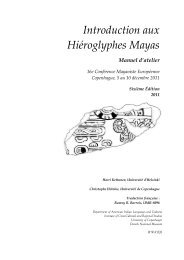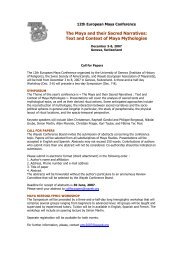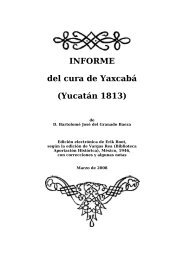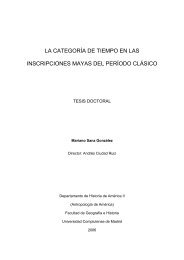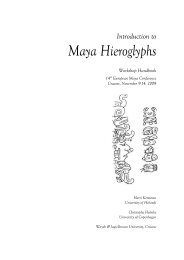Introduction to Maya Hieroglyphs - Wayeb
Introduction to Maya Hieroglyphs - Wayeb
Introduction to Maya Hieroglyphs - Wayeb
You also want an ePaper? Increase the reach of your titles
YUMPU automatically turns print PDFs into web optimized ePapers that Google loves.
Kettunen & Helmke 2011<br />
<strong>Maya</strong> <strong>Hieroglyphs</strong><br />
Figure 26: Map of the <strong>Maya</strong> area showing principal archaeological sites .................................................................... 46<br />
Figure 27: Codex style vase from the Late Classic Period .............................................................................................. 54<br />
Figure 28: The Landa Alphabet ......................................................................................................................................... 60<br />
Figure 29: Articulation places ............................................................................................................................................. 62<br />
Figure 30: Lintel 10, Yaxchilan, Mexico ............................................................................................................................ 65<br />
LIST OF TABLES 2 :<br />
Table I: Common Classic <strong>Maya</strong> vessel type glyphs ........................................................................................................ 33<br />
Table II: Comparisons between idealized vessel forms and written vessel type referents ........................................ 34<br />
Table III: Common royal titles ............................................................................................................................................ 44<br />
Table IV: Relationship glyphs ............................................................................................................................................. 44<br />
Table V: Vigesimal vs. decimal system .............................................................................................................................. 47<br />
Table VI: Applied vigesimal system for calendrical calculations .................................................................................. 47<br />
Table VII: Classic <strong>Maya</strong> numerals from zero <strong>to</strong> nineteen .............................................................................................. 48<br />
Table VIII: Organization of successive Tzolk’in dates ..................................................................................................... 49<br />
Table IX: Lords of the Night ............................................................................................................................................... 51<br />
Table X: Period names for Long Count dates and Distance Numbers .......................................................................... 55<br />
Table XI: Day names in the Tzolk’in calendar: Imix-Ok ................................................................................................ 56<br />
Table XII: Day names in the Tzolk’in calendar: Chuwen-Ajaw .................................................................................... 57<br />
Table XIII: “Month” names in the Haab calendar: Pop-Yax .......................................................................................... 58<br />
Table XIV: “Month” names in the Haab calendar: Sak-<strong>Wayeb</strong> ..................................................................................... 59<br />
Table XV: Classic <strong>Maya</strong> consonants ................................................................................................................................... 61<br />
Table XVI: Classic <strong>Maya</strong> vowels ......................................................................................................................................... 61<br />
Table XVII: Articulation organs and places ...................................................................................................................... 62<br />
Table XVIII: Examples based on harmony rules according <strong>to</strong> Lacadena and Wichmann (2004) ............................... 64<br />
Table XIX: Examples of underspelled words .................................................................................................................... 64<br />
Table XX: An example of varying spelling of the name Ahkul Mo’ from Lintel 10, Yaxchilan ................................... 65<br />
Table XXI: Classic <strong>Maya</strong> voice system ............................................................................................................................... 66<br />
Table XXII: Examples of grammatical changes in time and space: chum- ..................................................................... 72<br />
Table XXIII: Examples of grammatical changes in time: hul- ......................................................................................... 72<br />
Table XXIV: Concise Classic <strong>Maya</strong> – English Dictionary ................................................................................................ 93<br />
Table XXV: Examples of Classic <strong>Maya</strong> pronouns in the hieroglyphic texts ............................................................... 141<br />
2<br />
All drawings and graphics by Harri Kettunen unless otherwise indicated.<br />
4/154



